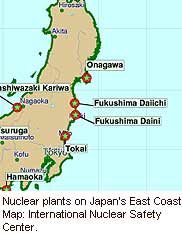
TUESDAY, Aug. 14 (HealthDay News) — More than one-third of residents of a town near the Japanese nuclear reactor that underwent meltdown last year showed evidence of exposure to radioactive cesium six months after the disaster, new research shows.
However, the levels aren’t terribly high — even those with the highest levels of radiation contamination still had levels that were lower than what would be treated with Prussian blue, which is used to remove radioactive materials from the body.
In addition, radiation levels in the Japanese six months after exposure were much lower than the levels seen in people exposed to Chernobyl, even seven to 10 years after the Ukraine nuclear accident, according to the study.
“Exposure levels were low in a majority of tested adults and children, and notably were much lower than those reported in studies even several years after the Chernobyl incident,” said study author Dr. Masaharu Tsubokura, of the Institute of Medical Science at the University of Tokyo.
The study is published in the Aug. 15 issue of the Journal of the American Medical Association.
Researchers used whole-body counters to measure radiation exposure in nearly 9,500 residents of Minamisoma, a town about 14 miles north of the plant and in the evacuation zone. Researchers were asked by the mayor to monitor the health of residents, Tsubokura explained.
On March 11, 2011, a magnitude 9.0 offshore earthquake caused a deadly tsunami, which knocked out the cooling system at the Fukushima Daiichi nuclear power plant, sending some reactors into meltdown and releasing radioactive material into the air, water and soil.
Most exposures likely happened with a week of the meltdown, Tsubokura said, when residents of Minamisoma inhaled airborne cesium. But some exposure could have happened when they were returning home after the evacuation and ate contaminated food, Tsubokura said.
Making sure people are eating a uncontaminated food supply is important in preventing long-term health consequences, he added.
“I don’t think that many people will experience long-term health problems related to the nuclear accident, if we can keep providing safe and uncontaminated food to the residents,” he said. “In Chernobyl, residents near the nuclear plant were still exposed to radiation even decades after the incident due to the intake of the contaminated food. Food control is the key issue in lowering internal contamination.”
Though the radiation levels don’t seem alarming, the health of people living near the plant will need to be tracked for years to come, said Dr. Dan Hanfling, special advisor for emergency preparedness and response for Inova Health System, in Falls Church, Va., and a clinical professor in the department of emergency medicine at George Washington University. Radiation exposure can raise the risk of cancer, and to what degree residents face ongoing exposure or long-term health risks is unknown, he said.
In a second study in the same journal, researchers found that many workers at the nuclear plant in Japan suffered psychological distress and post-traumatic stress symptoms several months after the catastrophe.
Researchers asked more than 1,000 workers from the Daiichi plant, which experienced meltdown, and 700 from the Daini plant, which was damaged but didn’t have meltdown, about feelings of psychological distress, including feeling nervous, hopeless, restless/fidgety, depressed and worthless.
About 47 percent of Daiichi workers reported psychological distress, compared with 37 percent of Daini plant workers, while 30 percent of Daiichi workers had signs of post-traumatic stress, compared with 19 percent of Daini workers.
After the disaster, the electric company that managed the plants was criticized for its response and the workers have been targets of discrimination, according to the study. Workers who were exposed to discrimination or slurs tended to have worse psychological distress.
“The public was horrified that the plant workers could allow the events to go as far as they did,” Hanfling said. “This sense of scapegoating or discrimination was a contributing factor to the perception of PTSD.”
In a commentary in the same journal, Hanfling wrote that large-scale disasters such as the Japanese tsunami, the Haitian earthquake and Hurricane Katrina offer a stark reminder of how vulnerable the United States and countries around the globe are to catastrophic events.
Large-scale events, whether natural or man-made, can quickly overwhelm emergency response and the health system’s ability to handle it, Hanfling said. Far more needs to be done to plan for such events and to coordinate efforts among health care workers’ federal, state and local governments; emergency responders and the public.
“Yet, despite the importance of developing well-coordinated plans, few communities have the level of integration necessary to provide oversight and care for an overwhelming number of victims and survivors,” he wrote.
More information
The Health Physics Societyhas more on radiation.

